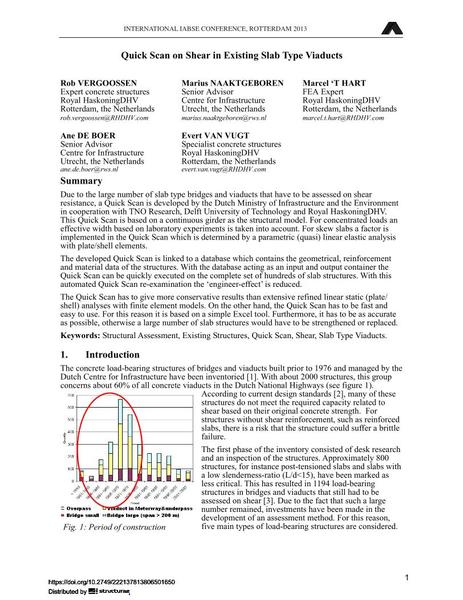Quick Scan on Shear in Existing Slab Type Viaducts

|
|
|||||||||||
Détails bibliographiques
| Auteur(s): |
Rob Vergoossen
Marius Naaktgeboren Marcel 'T Hart Ane de Boer Evert van Vugt |
||||
|---|---|---|---|---|---|
| Médium: | papier de conférence | ||||
| Langue(s): | anglais | ||||
| Conférence: | IABSE Conference: Assessment, Upgrading and Refurbishment of Infrastructures, Rotterdam, The Netherlands, 6-8 May 2013 | ||||
| Publié dans: | IABSE Conference, Rotterdam, May 2013 | ||||
|
|||||
| Page(s): | 352-353 | ||||
| Nombre total de pages (du PDF): | 8 | ||||
| Année: | 2013 | ||||
| DOI: | 10.2749/222137813806501650 | ||||
| Abstrait: |
Due to the large number of slab type bridges and viaducts that have to be assessed on shear resistance, a Quick Scan is developed by the Dutch Ministry of Infrastructure and the Environment in cooperation with TNO Research, Delft University of Technology and Royal HaskoningDHV. This Quick Scan is based on a continuous girder as the structural model. For concentrated loads an effective width based on laboratory experiments is taken into account. For skew slabs a factor is implemented in the Quick Scan which is determined by a parametric (quasi) linear elastic analysis with plate/shell elements. The developed Quick Scan is linked to a database which contains the geometrical, reinforcement and material data of the structures. With the database acting as an input and output container the Quick Scan can be quickly executed on the complete set of hundreds of slab structures. With this automated Quick Scan re-examination the ‘engineer-effect’ is reduced. The Quick Scan has to give more conservative results than extensive refined linear static (plate/ shell) analyses with finite element models. On the other hand, the Quick Scan has to be fast and easy to use. For this reason it is based on a simple Excel tool. Furthermore, it has to be as accurate as possible, otherwise a large number of slab structures would have to be strengthened or replaced. |
||||
| Mots-clé: |
structures existantes
|
||||
